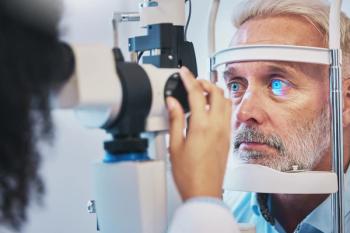
Lamina cribrosa deformation a potential prognostic factor in glaucoma
How much the lamina cribrosa curves inward could become a useful prognostic factor in glaucoma.
A recent study in early-stage patients with primary open-angle glaucoma (POAG) found a direct relationship between the degree of deformation in the lamina cribrosa and progressive loss of visual field, said Ahnul Ha, MD.
"The lamina cribrosa is already known as the primary site of pathogenesis in glaucoma," said Dr. Ha, Department of Ophthalmology, Seoul National University Hospital, Seoul, South Korea.
Lamina cribrosa deformation can directly block the excimer cells and the disturbed blood supply can accelerate retinal ganglion cell injury, Dr. Ha said.
"We found that with greater lamina cribrosa deformation, RGC axons are increasing vulnerable to further glaucomatous injury," Dr. Ha added. "Baseline lamina cribrosa morphology may eventually serve as a prognostic factor in patients with primary open-angle glaucoma."
The study followed 101 eyes with early-stage POAG for a mean of 3.6 years. In addition to conventional measures of glaucoma such as IOP and visual field parameters, researchers measured the deformation of the lamina cribrosa and created a lamina cribrosa curvature index (LCCI) as a measure of lamina cribrosa morphological change.Measurements were based on the Bruch's membrane opening (BMO) and the anterior lamina cribrosa insertion (ALI) as fixed reference points in each eye. Variables included the distance between the BMO reference plane and the ALI, the anterior lamina cribrosa insertion depth (ALID), and lamina cribrosa depth (LCD), the maximum inward curvature in the lamina cribrosa. The mean LCCI was computed using an average of 12 radial measurements around the periphery of the lamina cribrosa.
All of the measurements based on scans from a DRI OCT-1 Atlantis 3D SS-OCT (Topcon ) OCT radial scan. All of the images were enhanced with an adaptive compensation technique, Dr. Ha said. Poor quality scans that did not provide accurate measurements were excluded.
Patients in the study had early-stage POAG with a mean visual field deviation of more than -5.0 dB and well-controlled IOP. Eyes with a history of intraocular surgery except uncomplicated cataract were excluded. Any eyes with poster pole lesions that affected the visual field were also excluded.
The mean age of patients was just over 64 years and slightly more than half (53%) were male. Pre-treatment IOP was 16.2 mm Hg and the mean post-treatment IO was 12.4 mm Hg, a mean IOP reduction of 23.4%.
Visual field testing showed a baseline mean deviation of -3.8 dB and a baseline pattern standard deviation of 5.1. Patients had a mean of 7.2 visual field exams over a mean follow up period of 3.6 years, or a visual field exam roughly every six months.Univariate analysis showed four factors associated with visual field progression, greater IOP fluctuation, greater initial visual field PSD, mean baseline LCD, and mean baseline LCCI.
"In the multivariate analysis, only the mean baseline LCCI was statistically significant," Dr. Ha said. "A baseline LCI of 152.4 micrometers was identified as the significant break point. If the baseline LCCI is greater than 152.4 micrometers, the visual field progressed by -0.01 dB per year as the LCCI increased by one unit. Greater lamina cribrosa curvature places a heavier burden on the RGC axons."
Increasing posterior lamina cribrosa bowing induced by elevated IOP creates increasing stress and strain on axons, blood vessels, and other tissues. The mechanical response of the lamina cribrosa under stress from elevated IOP is affected by age, racial differences, and variation between individuals.
Participants ranged from the late 40s to the mid-70s in age. And as expected, the rate of MD progression in the study group was affected by age at baseline.Patients who were less than 68 years old at baseline showed slower visual field progression than patients who were older than 68. Eyes in the younger age group showed a visual field mean deviation of -0.004 per year compared to -0.002 in older eyes.
The age-dependent difference could be a function of mechanical changes in the lamina cribrosa over time.
Dr. Ha noted that the mechanical flexibility of the lamina cribrosa declines with age. That means younger eyes with more pliant and flexible membranes may suffer more damage to axons and other structures passing through the laminal pore. Older eyes may be somewhat protected from mechanical stress and damage by having a less pliant lamina cribrosa that causes fewer structural changes in the laminar pore.
Although the relationship between increasing baseline LCCI and faster visual field progression is clear, Dr. Ha said her institution does not routinely use LCCI in clinical practice. Performing the scans needed to assess LCCI is a currently time consuming and costly procedure, she said.
"In the future, there might be a system that would allow us to use the lamina cribrosa curvature as a prognostic factor," Dr. Ha said.
Disclosures:
Ahnul Ha, MD
e.
This article was adapted from Dr. Ha's presentation at the 2017 meeting of the American Academy of Ophthalmology. Dr. Ha did not indicate a proprietary interest in the subject matter.
Newsletter
Want more insights like this? Subscribe to Optometry Times and get clinical pearls and practice tips delivered straight to your inbox.













































